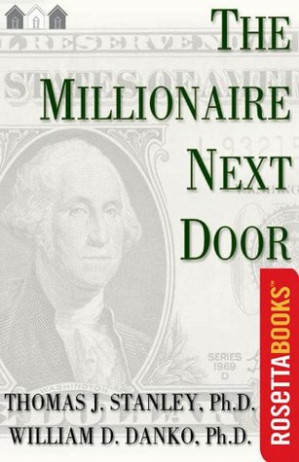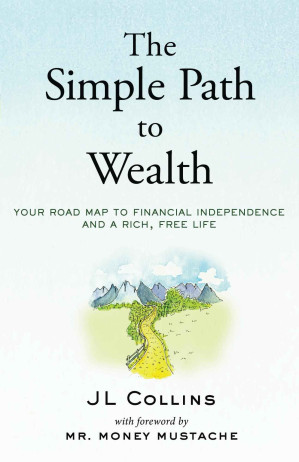Live well below your means—wealth is what you don't spend.
Most millionaires live in middle-class neighborhoods, drive used cars, and avoid status symbols.

Book summary
by Stanley & Danko
The Surprising Secrets of America's Wealthy
Research revealing surprising habits of actual wealthy individuals
Topics
Read this book chapter by chapter, calculating your own PAW/UAW status after each section. Use Readever to track your financial habits against the seven characteristics of millionaires, creating a personalized wealth-building plan. Highlight specific frugality strategies and set reminders to review your progress monthly. Use the AI to translate research findings into actionable steps for your income level and lifestyle.
Things to know before reading
The Millionaire Next Door shatters the myth that wealthy people drive luxury cars, wear designer clothes, and live in mansions. Based on decades of research into America's millionaires, Thomas Stanley and William Danko reveal that most wealthy individuals are frugal, live well below their means, and prioritize financial independence over conspicuous consumption. They're the quiet neighbors next door who built wealth through discipline, hard work, and smart financial habits rather than inheritance or lottery wins.
*The Millionaire Next Door* reveals seven key characteristics that distinguish America's actual millionaires from those who just appear wealthy.
Most millionaires live in middle-class neighborhoods, drive used cars, and avoid status symbols.
The authors created a formula to classify people as Prodigious Accumulators of Wealth (PAWs), Average Accumulators (AAWs), or Under Accumulators (UAWs).
Millionaires spend significant time planning their finances and investments.
Millionaires prioritize freedom and security over impressing others.
Most millionaires are self-employed or business owners.
Ready to continue? Launch the Readever reader and keep turning pages without paying a cent.

Morgan Housel
Timeless lessons on wealth, greed, and happiness through psychology

Robert T. Kiyosaki
Financial education through contrasting mindsets of fathers

J.L. Collins
Roadmap to financial independence through simple investing

Benjamin Graham
Definitive value investing guide emphasizing safety margins
This summary gives you the blueprint for building sustainable wealth by adopting the counterintuitive habits of America's actual millionaires. You'll learn how to calculate your expected net worth, identify whether you're an under-accumulator or prodigious accumulator of wealth, and implement the seven common characteristics that separate the truly wealthy from those who just look rich.
Key idea 1
Most millionaires live in middle-class neighborhoods, drive used cars, and avoid status symbols.
Stanley and Danko's research shows that true millionaires practice frugality as a lifestyle. They don't buy luxury cars, designer clothes, or expensive homes to signal status. Instead, they focus on building wealth through consistent saving and investing. The average millionaire spends less than they earn, budgets carefully, and views consumption as a barrier to financial independence rather than a reward for hard work.
Remember
Key idea 2
The authors created a formula to classify people as Prodigious Accumulators of Wealth (PAWs), Average Accumulators (AAWs), or Under Accumulators (UAWs).
Stanley and Danko developed a simple formula to measure wealth accumulation: Expected Net Worth = Age × Annual Pre-tax Income ÷ 10. If your actual net worth is twice this amount or more, you're a PAW. If it's half or less, you're a UAW. This framework helps you benchmark your financial progress and understand whether you're building wealth effectively or just maintaining appearances.
Remember
Key idea 3
Millionaires spend significant time planning their finances and investments.
Wealthy individuals dedicate substantial time to budgeting, tax planning, investment research, and financial goal setting. They treat wealth building as a serious business, not an afterthought. This systematic approach to financial planning allows them to maximize returns and minimize taxes, accelerating their path to financial independence.
Remember
Key idea 4
Millionaires prioritize freedom and security over impressing others.
The research reveals that truly wealthy people value financial independence far more than displaying high social status. They're willing to drive modest cars, live in regular neighborhoods, and avoid luxury brands if it means building lasting wealth. This mindset shift—from external validation to internal security—is fundamental to accumulating substantial net worth.
Remember
Key idea 5
Most millionaires are self-employed or business owners.
Stanley and Danko found that while only 20% of American households are headed by self-employed individuals, they represent two-thirds of millionaires. Business owners and professionals have more control over their income, can reinvest profits tax-efficiently, and build businesses that appreciate in value. This entrepreneurial path, while riskier, offers significantly higher wealth-building potential.
Remember
The Millionaire Next Door is a groundbreaking study of wealth in America that challenges conventional wisdom about millionaires. Based on extensive surveys and interviews with actual millionaires, Thomas Stanley and William Danko reveal that most wealthy Americans don't fit the flashy, high-consumption stereotype. Instead, they're typically business owners, self-employed professionals, or corporate executives who built wealth through consistent saving, disciplined spending, and smart investing over decades.
The book introduces concepts like "PAWs" (Prodigious Accumulators of Wealth), "UAWs" (Under Accumulators of Wealth), and provides a formula to calculate expected net worth. It examines the spending habits, career choices, and lifestyle decisions that separate the truly wealthy from those who just appear rich.
Open Readever's reader to highlight passages, ask the AI companion questions, and keep exploring without paying a cent.
The Millionaire Next Door stands as one of the most influential personal finance books ever written, selling over 3 million copies and remaining relevant decades after its initial publication. The research methodology—conducted over 20 years with thousands of millionaires—gives the book unparalleled credibility. Stanley and Danko's findings continue to surprise readers who expect wealthy people to live lavishly, when in reality most practice extreme frugality.
Critical Reception: The book became an instant bestseller and has been praised by financial experts for its data-driven approach and counterintuitive insights. It's frequently recommended alongside classics like Rich Dad Poor Dad and The Intelligent Investor for its practical, actionable advice about building wealth through discipline rather than luck or inheritance.
Anyone seeking to build long-term wealth through disciplined habits
Young professionals establishing financial foundations
People who feel trapped by lifestyle inflation and consumer debt
Business owners and entrepreneurs looking to optimize personal finances
Parents wanting to teach children about sustainable wealth building
Anyone who believes high income alone leads to wealth
Thomas J. Stanley (1944-2015) was an American author and researcher who specialized in studying wealth in America. He earned his PhD from the University of Georgia and taught marketing at Georgia State University. Stanley conducted extensive research on millionaires for over 20 years, publishing multiple bestselling books on wealth accumulation. His work focused on understanding the behaviors and characteristics of America's wealthy.
William D. Danko is a marketing professor at the University at Albany, State University of New York. He earned his PhD from Rensselaer Polytechnic Institute and has published extensively in academic journals. Danko collaborated with Stanley on the research that formed the basis for The Millionaire Next Door, bringing academic rigor to the study of wealth accumulation patterns.
Together, Stanley and Danko created one of the most influential personal finance books of all time, changing how millions of people think about wealth, consumption, and financial independence.
Build your personalized reading stack
Download full-length ePubs in one click with personal cloud storage.
Blend AI-guided insights with tactile note-taking to accelerate reflection.
Follow curated reading journeys tailored to your goals and time budget.
Sync highlights across devices so lessons stick beyond the page.
Sign in to Readever to keep reading with AI guidance, instant summaries, and synced notes.
The Millionaire Next Door proves that true wealth isn't about flashy cars, designer clothes, or expensive homes—it's about discipline, frugality, and consistent saving. The book's most powerful insight is that most millionaires are ordinary people who made extraordinary financial decisions over decades. By living below their means, avoiding debt, and investing wisely, they achieved financial independence without the outward signs of wealth that society expects.
The research provides a roadmap for anyone willing to prioritize financial security over status symbols. It reminds us that wealth is built through what we don't spend, not through what we earn. The principles remain timeless: spend less than you earn, invest the difference, and focus on building net worth rather than maintaining appearances.
This extended outline captures The Millionaire Next Door's key insights and practical applications. Use it to revisit the book's core concepts and apply them to your personal or professional growth.
The book's enduring value lies in its demonstration that meaningful insights can transform understanding and practice.
Start reading The Millionaire Next Door for free and unlock personalized book journeys with Readever.